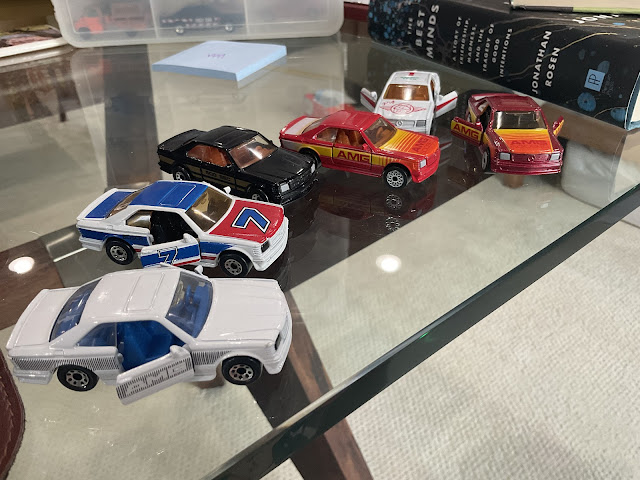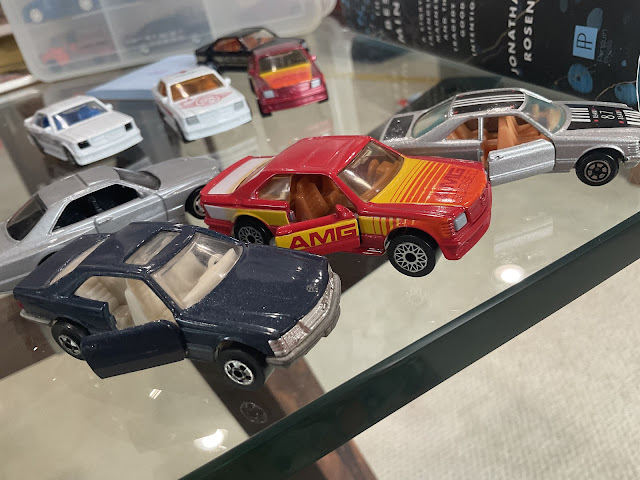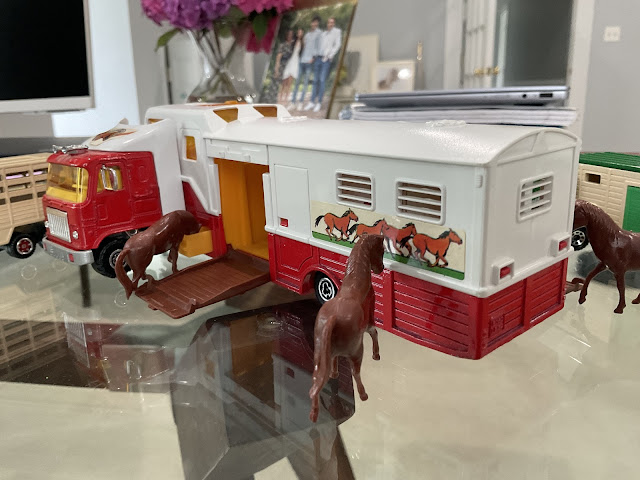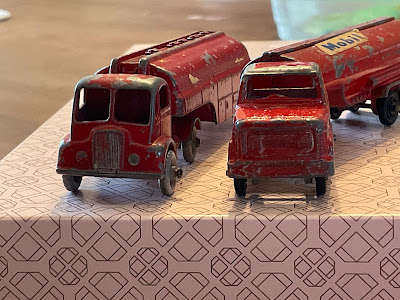
Matchbox Frenzy
A way to share my love of all 1/64 diecast toy cars (AKA Matchbox and How Wheels, but also all of the lesser-known brands) with anyone who will read it... (And much to the relief of my family and friends who are sick of hearing me talk endlessly about toy cars).
Total Pageviews
Thursday, June 26, 2025
Another sharp Yatming copycat of a classic Tomica from their golden era; Lincoln Continental Mark IV

Monday, December 23, 2024
Almost identical classic castings of a Cadillac Brougham - from Tomica and Yatming
These are 2 of my favorite classic castings - a big, fully-size classic luxury car - a 1970s Cadillac Brougham. Hefty, with a soft, luxurious suspension.
They are so similar that, for a long time, I conflated them in my mind as the same casting - just in different colors. But in fact they are unique and individual castings. The blue one is by Tomica - and its quality is consistent with Tomica’s legendary quality standards. But the maroon one is by Yatming - it’s a copycat of the Tomica casting - but a really well done copycat - such that it is a contender for the best Yatming of all time…
Which is better? Well - it’s hard to beat classic Tomica when they were on their “A” game, and indeed they win this competition - but just barely. Yatming brought a good fight to this match. The wheels on the Tomica are better. The Tomica is slightly better done with slightly better detail (note the unsightly excess metal on the Yatming’s trunk). Plus, the Tomica’s paint hue is better - the Yatming is a somewhat bland burgundy to the Tomica’s rich blue. But other than that the Yatming is a glorious contender.
There is really no big reveal or conclusion here - just a short article featuring 2 nicely done castings - 1 a copycat of the other - by Tomica and Yatming in their prime. 2 of my favorite cars…
Sunday, July 21, 2024
Who makes the best of the Mercedes 560 SEC / 500 SEC - the coolest, most bad-ass car of the late 1980s - the “I’m a Miami drug kingpin, this is my car - don’t mess with me!!!”?
But THEN…. …I found a vintage Road Champs model of the 500SEC, in a rich shade of dark blue, with opening doors and a metal base! A great car and a great find… ...and as long as I was including THAT one, I felt I had to also include Yatming's version of the 500SEC, particularly since it was one of Yatming’s stronger models, again with opening doors and metal base. I have 2 of that casting in identical silver paint.
All of which sets up for a compelling comparison test!While all 4 castings are undeniably cool on their own, all great models, all faithfully replicating the coolness of the authentic SEC, all with certain advantages…. …still not all of the 4 castings compete at the same level. In any competition there are winners and non-winners, and that is certainly the case here.
As much as I root for the underdog, and like the early high-quality Yatming castings, the Yatming is unquestionably the laggard of the group - it makes for an easy-to-determine 4th place finish. It’s still a great casting, with a real metal base, a separate insert for the front grill/bumper/headlights (though that insert looks a little cheaply/plasticky), good detail, a soft suspension, opening doors, cream-colored interior, etc., etc., etc. On its own, it’s great, but in comparison to the others, it just doesn’t look as tough as the others. The Matchbox and Hot Wheels are models of the AMG modified SEC, whereas the Yatming and the Road Champs are models of the normal (still very nice!) Mercedes, and the difference is evident. It just looks less muscular than the Matchbox and Hot Wheels…. …and it relegates the Yatming to a (strong) last place.The next casting that gets eliminated is the Road Champs, really for the same reason as the Yatming. It’s essentially a nicer version of the Yatming, a better model of the normal SEC rather than the ultra-tough AMG monster SEC. …But the regular SEC still oozed class, more class than anything on the road aside from a Bentley Turbo R, and here the Road Champs finds its niche. It beats the nice Yatming in almost every category (save for perhaps the silkiness of its suspension). It’s bigger, meatier, with richer classy dark blue paint, a more substantial baseplate, a metal insert for the front clip that drips with detail (down to the headlight windshield wipers!), a cast-in-metal 3-pointed star on the hood, a glass sunroof, etc. etc. etc. This is a Great model! …but just not as great as the next 2 models. I love it - but not enough to move it beyond 3rd place.Saturday, July 20, 2024
Cool Green Livestock Tractor Trailers from Diecast stalwarts Matchbox and Majorette! (and a surprise additional rig is included at the end of the blog post!)
 Ah - so here's the rub... As you'd expect from one of my blog posts, I'm writing this post because we have another vintage offering - a similar Kenworth pulled livestock tractor trailer contender from Majorette - in almost the exact same color scheme as the Matchbox! Time for a comparison test! Which of the 1980s diecast heavyweights made the best livestock tractor trailer?!?
Ah - so here's the rub... As you'd expect from one of my blog posts, I'm writing this post because we have another vintage offering - a similar Kenworth pulled livestock tractor trailer contender from Majorette - in almost the exact same color scheme as the Matchbox! Time for a comparison test! Which of the 1980s diecast heavyweights made the best livestock tractor trailer?!? Sunday, March 31, 2024
The Tootsie-Toy model that (almost!) beats out a cool, antique Lesney Matchbox casting - a stalwart model of any Lesney aficionado's collection!
 Tootsie-toys were cheapy - without interiors - without glass - without suspensions... ...cheap drugstore 5-packs of cars that uncles and aunts would give you to fill out your collection - with their undiscerning eyes failing to grasp how much of a throw-away toy they just got you...
Tootsie-toys were cheapy - without interiors - without glass - without suspensions... ...cheap drugstore 5-packs of cars that uncles and aunts would give you to fill out your collection - with their undiscerning eyes failing to grasp how much of a throw-away toy they just got you...














































